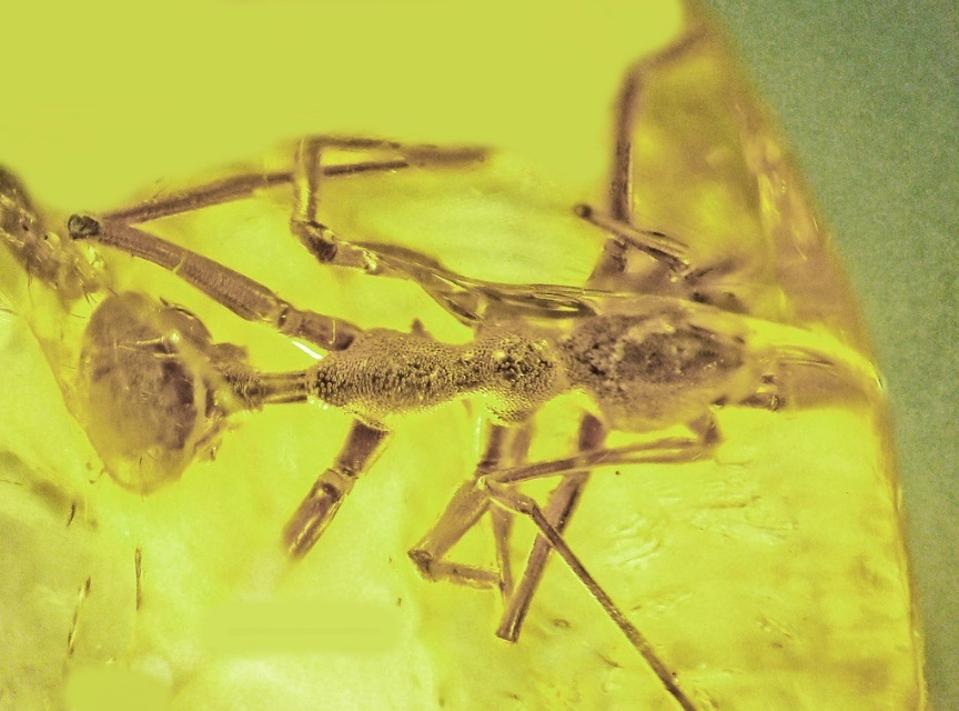In the creature-eat-creature world of nature, avoiding predators is a high-stakes game that requires ingenuity. Exhibit A: spiders that disguise themselves as ants to stay alive.
Why mimic ants, of all fellow critters? Ants can defend themselves aggressively, making them less appetizing to arthropods on the prowl for lunch.
“They have a strong bite as well as a stinging venom, and they can call in dozens of nestmates as allies,” said paleobiologist George Poinar Jr. “Spiders, meanwhile, have no chemical defenses and are loners, which makes them vulnerable to being hunted by larger spiders, wasps and birds, predators that would rather avoid ants. So if a spider can be like an ant, it’s more likely to be unbothered.”
Poinar, a professor emeritus in the College of Integrative Biology at Oregon State University who inspired the science in Jurassic Park, is author of a study that describes a new species of ant-mimicking spider found entombed in fossilized resin, intact save for the tips of some of its legs. Spiders that impersonate ants live around the world, but most have managed to dodge detection by fossil researchers as well as predators. The study, published earlier this month, appears in the journal Historical Biology.
When sticky tree resin hardens and fossilizes, it turns into amber and its less mature cousin copal. As these materials solidify, they often trap life forms, offering a fascinating window into the distant past. Poinar is something of resin royalty, having studied everything from amber-preserved insects to prehistoric flowers to ancient fungus, monkey blood and new species of wasps.
The resin containing the spider described in the study came from Medellin, Colombia. Because of the copal block’s tiny size, age-testing the material the typical way, using acetone and a hot needle test, could have damaged the spider inside, Poinar pointed out. Copal can date back up to 3 million years.
But even if we don’t know exactly when the preserved spider tried to pass itself off as an ant, the copal sample offers a rare fossilized glimpse at an intriguing adaptive behavior.
Masters Of Disguise
Nature contains many examples of creatures that mimic other life forms to avert predators, changing colors, for example, to blend into their surroundings. But it’s quite a feat for spiders, which have eight legs and no antennae, to make themselves look like they have six legs and two long antennae.
To do that, ant-mimicking spiders typically reposition their two front legs to look like antennae. But that’s not all the morphing they need to do to outrun predatory birds, lizards, insects and fellow spiders.
“The abdomen and cephalothorax of spiders are closely attached, while in ants the equivalent of these body parts are separated by a narrow segment called the petiole,” Poinar said in a statement. “And there are many other lesser structures that need to be modified in spiders for them to closely resemble ants.”
Most scientists say the morphing begins with spider mutation, adaptation and then natural selection. But Poinar posits there could be more at play.
“I think there is some spider reasoning and intelligence involved too since the spiders often model their body changes after specific ants in the same environment,” he said. “In the early days, we were told that all habits of insects were the result of instincts, but that is no longer the case.”
But while ant-mimicking spiders may have earned a top spot on the list of nature’s most talented contortionists, their skills appear to come at a cost. Other studies have concluded that the machinations required to disguise themselves impair the arachnids’ own hunting ability.

